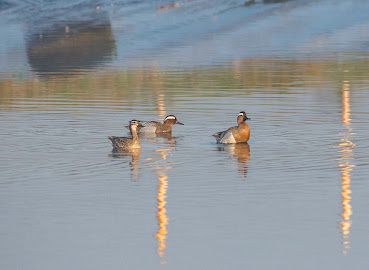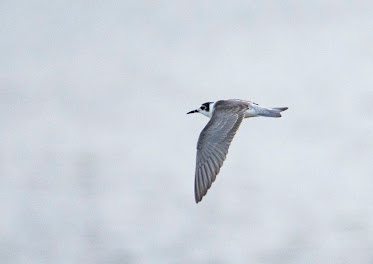2022 was pretty enjoyable in birding terms. My core area – south-west Surrey (SWS) – produced plenty of quality moments and satisfying finds. Within that, my new '1-km' Eashing area patch was a revelation in terms of reconnecting with the core patch feeling, which I haven't had since calling it a day at Thorncombe Street. The only minor blemish on 2022 was missing a few good county birds. You can't have it all though!
 |
| Wood Sandpiper at Thursley. |
South-West Surrey
Year list total: 158
I found 2021 rather frustrating in SWS, so 2022 marked a welcome return for form. 158 is actually a very good tally, too – only one behind my 2020 big year total. The weather was less than ideal in large parts, including a spring of high pressure and many migrant-less mornings, a boiling hot summer and a westerly dominated October and November. One theme of 2022, however, was that when the birding was good, it was really good, often in relatively short bursts too (i.e. late March, early May and mid-August to early September).
Five SWS lifers were good going as well (c.f. three in 2021): Sandwich Tern, Turnstone, Ruff, Wood Sandpiper and Black Tern. That three of them were self-found makes them all the more sweeter. I didn't find a showstopper rarity in 2022, but the relatively consistent spread of highly satisfying local finds throughout the year negated this. Another positive was that I didn't miss anything significant (versus missing some absolute megas in 2021!). In total I missed three species, meaning the SWS 2022 total is 161 (c.f. 163 in 2021 and 167 in 2020).
 |
| Sandwich Tern. |
Studying rare breeders is a big part of my birding and 2022 was relatively good in this respect, though not as productive as 2021. I failed to find a Lesser Spotted Woodpecker nest or confirm breeding Hawfinch and Turtle Dove, but did manage to (finally) pin down a Goshawk nest (and monitor another), came very close to doing the same for Honey Buzzard and confirmed nesting of a few other rare county breeders (Snipe, Teal, Curlew etc).
For the second year in a row, vis-mig was fairly dire. We can only hope we get an overdue good autumn in 2023 …
It's hard to pick a top five moments, but here goes (in no order):
March Garganey at Tuesley
One of my favourite species, I've always wanted to find Garganey locally, and it happened on 21 March when two drakes and a female appeared out of the early morning mist. I couldn't have dreamed they'd be as confiding as they were, too, as they spent the day on site. A perfect start to spring.
 |
| Garganey. |
Pudmore wader-fest in September
Finding a juvenile Ruff at Thursley on 1 September was a year highlight on its own. However, the next day it was joined by a juvenile Wood Sandpiper – and a seriously showy one too. The next couple of weeks saw these local rarities (mega in the case of Ruff!) grace Pudmore, which was exceptionally muddy due to the dry summer. This was also the last summer that the boardwalks were down post-2020 fire, meaning the birds were tamer than usual.
Ring recoveries
Kind of merging two in one here, but it was hugely satisfying to trace the rings of two rare birds: the Thursley
Wryneck from late August (ringed in Suffolk; see
here) and a male
Honey Buzzard (ringed four years ago as a chick on a nest some 15 km away from where I saw it).
 |
| Honey Buzzard. |
A certain Goshawk pair
Having kept tabs (or, rather, been given the run around!) by a particular pair of Goshawks for a number of years now, it was a true joy to finally nail the nest and then accompany Jeremy to ring the two chicks.
Tuesley Turnstone
After weeks of tiring graft, my big spring passage reward came just before I left for Lapland – a simply spanking summer-plumage male Turnstone at Tuesley, that showed like a charm in the evening sunshine. Only the 12th for SWS and the first in a decade.
 |
| Turnstone. |
There were plenty of other cracking moments too. Some of them include cashing in on the August Pied Flycatcher influx (two finds and a third bird seen), the bumper spring Whimbrel passage, finding Thursley's first (and SWS's 12th) Rock Pipit and so on.
Eashing 1-km
Year list total: 111
After we
moved to Eashing in January, I decided to draw up a rough 'Eashing area' patch and study the birds in it. This proved incredibly fun! It was like having a patch within a patch. It provided all the micro-level quirks that only patch-watching can – a feeling I've missed since leaving Thorncombe Street.
Having such a connection with a place and time, and learning the context of the birds within that, gives probably the most uplifting feeling I've personally found within birding. An added bonus is that all the birding can be done on foot from my front door.
As mentioned, I've done an Eashing area bird report for 2022 and will post/link it here soon. My target for the year was 90 species – I surpassed that by quite a stretch! There were innumerable highlights, but five of the best are below …
Bumper Eashing Fields vis-mig
In an autumn of poor vis-mig, an epic session at Eashing Fields on 21 October produced various highlights, the best of all was a flock of 15 Brent Geese heading west during a squall. All the way from Russia – mega! Add in a Woodlark (the only 2022 record), 1,500 Redwings, two Bramblings and three Mute Swans to make for a quality session.
 |
| Brent Geese. |
Winter wonderland along the Wey
An hour-along the Wey on 14 December in glorious, frosty conditions produced an extraordinary run of patch goodies. A flock of 17 Lapwings, a Woodcock, three Snipe, two Mute Swans, a Little Grebe, a Peregrine, a Water Rail and a Little Egret all led up to the grand finale – a Jack Snipe at Eashing Marsh.
After work Wheatear
Following a day of work on 28 March, I popped up to Eashing Fields and one of the first birds I saw was a cracking male Wheatear along a fence line. Literally a few hundred metres from home, this symbolic commencement of spring is always a year highlight. A whacky sighting of a Shoveler pair high overhead shortly after added to the visit.
 |
| Wheatear. |
Whinchat extravaganza
August and September saw bumper numbers of Whinchat pass through Surrey, and Eashing Fields was cashing in. On 2 September I counted a minimum of nine – easily a Surrey high count for me. An adult Hobby and a Yellow Wagtail contributed to that glorious late summer/early autumn feel.
Double at the res
A rainy visit to Eashing Farm on 14 September resulted in a mad 10-minute spell by the reservoir. First, a juvenile Osprey flew low south-west, affording brilliant views. Shortly after, a Ringed Plover zipped through south. A crazy double-act.
 |
| Osprey. |
Also, a very honourable mention to the two Marsh Harriers over the Wey on 24 September, a Great Crested Grebe over my garden on 12 October, no fewer than three Hawfinch records and the Dartford Warbler at Eashing Fields on my first ever visit to the site in mid-January.
Surrey
It was a poor year for vice-county ticks. Thankfully I connected with the gettable 'big one': a stunning Lesser Yellowlegs at Queen Elizabeth II Reservoir on 2 June (thanks Chris!). Only the second for Surrey (and first since 1984), this came during a mad little spell of county megas – annoyingly I didn't score the other two!
 |
| Lesser Yellowlegs. |
The other 'big one' was an Icterine Warbler that was suppressed at Leith Hill on 3 June. It's probably less likely to occur than lesserlegs … merely two days later, I missed a Purple Heron at Beddington by five minutes. These are such slippery customers in Britain – this is now the third I've dipped (Purple Heron remains the most obvious absentee from my British list).
I also dipped the Tice's Spoonbill in late May, which flew off about half an hour before I was due to arrive straight from Gatwick! Finally, rounding off a year of VC dips, I missed the South Bank Guillemot in September (although a fun, green twitch was enjoyed!).
The only other county tick I managed was Black Tern (at Frensham, found by Shaun), which was the striking omission from my Surrey list (borne out of the fact I refused to go for one outside of SW Surrey).
 |
| Black Tern. |
Now I'm on 230 for the vice-county, the law of diminishing returns means I shouldn't expect a hatful of county ticks each year. However, given I added eight new birds in 2020 and seven in 2021, two in 2022 is a less than ideal return. Hopefully 2023 is better in this department!











No comments:
Post a Comment